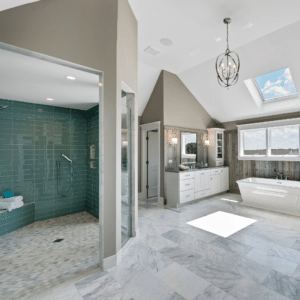Frank Lloyd Wrights impact on commercial architecture is both profound and enduring, influencing generations of architects and developers. His innovative designs and visionary approach have reshaped the way commercial spaces are conceived. This article seeks to explore Wright’s lasting legacy in the commercial sector, offering valuable insights for those looking to meld historical inspiration with modern commercial design needs.
Frank Lloyd Wrights impact on commercial architecture is characterized by his emphasis on Organic Architecture, integration with the natural environment, and the pioneering use of materials and construction techniques. His philosophies have guided the development of functional, aesthetically appealing commercial environments that prioritize the human experience and environmental sustainability.
Key Takeaways:
- Frank Lloyd Wrights impact on commercial architecture is profound, influencing design principles that prioritize harmony between human habitats and the natural environment.
- Organic Architecture principles, evident in Wright’s designs like the Guggenheim Museum, promote dynamic and engaging commercial environments.
- Integration with the natural environment through features like extensive glass and natural light enhances sustainability and user experience in commercial spaces.
- Wright’s innovative use of materials and construction techniques continues to inspire architects, particularly on the East Coast, where historical and modern architectural blends present unique challenges.
- Sustainability was a central tenet of Wright’s designs, emphasizing practices such as natural heating and cooling, solar gain, and local materials, which are increasingly relevant in the face of climate change.
- Human-centric design, focusing on inspiring, comforting, and motivating occupants, is a hallmark of Wright’s influence on commercial architecture.
- Frank Lloyd Wrights impact on commercial architecture is evident in contemporary projects that draw upon his principles to create innovative, sustainable, and community-oriented spaces.
- The future of commercial architecture will continue to be shaped by Wright’s emphasis on sustainability, integration with nature, and prioritization of the human experience.
For professionals and enthusiasts eager to understand how Wright’s design ethos can be applied to today’s commercial architecture challenges, continue reading. We’ll delve into the principles that underpin his work and illustrate how they can inform the creation of commercial buildings that are not only visually striking but also sustainable and harmoniously integrated with their surroundings.
Wright’s Architectural Philosophy
Frank Lloyd Wright’s philosophy of Organic Architecture proposed a harmonious relationship between human habitats and the natural world. This concept not only revolutionized residential design but also had a significant impact on commercial architecture. Wright believed that commercial buildings should serve the needs of humanity while respecting their environmental context.
Frank Lloyd Wrights Impact on Commercial Architecture
Organic Architecture in Commercial Spaces
The application of Organic Architecture principles in commercial spaces is vividly illustrated by Frank Lloyd Wright’s design of the Solomon R. Guggenheim Museum in New York. While primarily an art museum, the Guggenheim’s unique, spiral structure and open, flowing interior defy traditional architectural norms, setting a precedent for commercial architecture. Its innovative design facilitates a seamless flow of space, encouraging exploration and interaction. This architectural masterpiece not only enhances the aesthetic appeal of its surroundings but also promotes a dynamic and engaging environment. Wright’s influence on commercial spaces through the Guggenheim exemplifies how Organic Architecture can transform public spaces into captivating and immersive experiences.
Integration with the Natural Environment
Frank Lloyd Wrights impact on commercial architecture is prominently reflected in his designs that incorporate extensive use of glass and natural light, effectively bringing the outside in. This integration fosters a connection with the natural environment, enhancing occupant well-being and setting a benchmark for sustainable commercial architecture. East Coast architects, inspired by Wright’s methodologies, have adopted these elements to not only minimize energy consumption but also to enrich the user experience. Wright’s visionary approach demonstrates how commercial buildings can be designed to be both environmentally responsive and aesthetically pleasing, underscoring his lasting influence on the architecture industry.
Pioneering Materials and Construction Techniques
Another Frank Lloyd Wrights impact on commercial architecture is markedly evident in his pioneering use of materials and construction techniques. Wright’s forward-thinking application of steel and concrete revolutionized the potential for commercial architecture, allowing for greater creativity and adaptability in design. This innovation has served as a catalyst for architects, especially in regions like New Jersey and the East Coast, encouraging them to push the boundaries of traditional and modern architectural practices. Wright’s approach has opened up new avenues for exploring design possibilities, proving that his contributions to commercial architecture continue to inspire and challenge the industry’s conventions.
Sustainability in Wright’s Commercial Designs
Long before it became a global imperative, Wright championed sustainability in his projects. His designs utilized natural heating and cooling, solar gain, and local materials, principles that are now central to green commercial architecture. These practices are increasingly relevant in the face of climate change, where architects are tasked with designing buildings that can withstand rising sea levels and more extreme weather patterns.
Human Experience and Environmental Sustainability
At the heart of Frank Lloyd Wrights impact on commercial architecture is his focus on the human experience. Wright-designed commercial spaces are not just buildings; they are environments that inspire, comfort, and motivate those who use them. This human-centric approach has influenced the design of commercial projects in New Jersey and across the East Coast, where developers are seeking to create spaces that foster community, productivity, and well-being.
Wright’s Legacy and Future Directions
Frank Lloyd Wrights impact on commercial architecture has profoundly shaped the field, embedding principles of Organic Architecture, sustainability, and human-centric design into the fabric of modern commercial spaces. Wright’s legacy is visible in the emphasis on environmental stewardship and innovative design that characterizes contemporary architecture.
Looking forward, his influence is expected to guide further innovations in sustainable building practices and technologies, promoting designs that respect both the environment and the well-being of occupants. As we navigate the challenges of urbanization and climate change, Wright’s visionary approach offers a roadmap for creating functional, sustainable, and harmonious commercial environments.
Elevating Commercial Architecture with Wright’s Legacy
Frank Lloyd Wrights impact on commercial architecture remains a beacon of innovation, sustainability, and human-centric design. As we look to the future of commercial architecture in New Jersey, the East Coast, and beyond, Wright’s principles continue to inspire a new generation of architects to imagine and create spaces that elevate the human experience while respecting the natural world.
Experience the transformative power of visionary architecture inspired by Frank Lloyd Wright. Let Guzzo Architects bring your commercial spaces to life with designs that elevate the human experience while respecting the natural world. Elevate your project to new heights. Contact Guzzo Architects at 201-939-1446
What are some specific examples of Frank Lloyd Wright’s commercial architecture?
Frank Lloyd Wright’s contributions to commercial architecture, while less numerous than his residential projects, include several notable examples that embody his innovative approach and design principles. Among these, the Larkin Administration Building in Buffalo, New York, although no longer standing, was revolutionary for its time, introducing open floor plans and modern office amenities. The Johnson Wax Headquarters in Racine, Wisconsin, is another exemplary project, celebrated for its use of natural light through Wright’s design of the iconic dendriform columns and Pyrex glass tubing in the Great Workroom. Additionally, the Solomon R. Guggenheim Museum in New York City, primarily an art museum, reflects Wright’s commercial design sensibilities with its unique spiral ramp and open atrium, challenging traditional museum layouts and offering a new way to experience art. These projects showcase Wright’s ability to apply his Organic Architecture principles to commercial spaces, integrating functionality with a deep respect for natural beauty and human experience.








